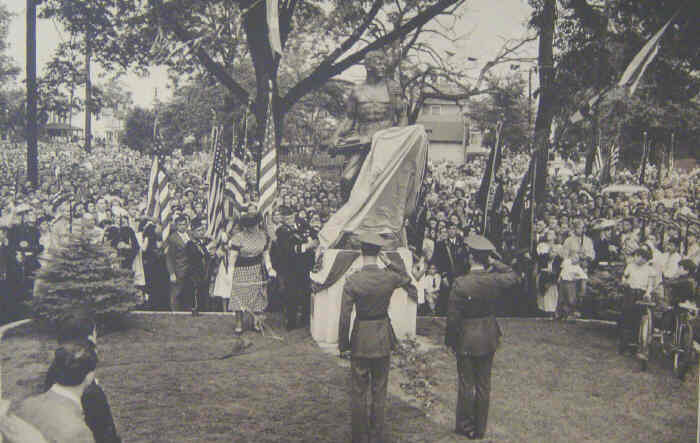
It was decided that the statue would be life size, mounted on a four foot granite pedestal. To get started, Philip Orlando built two smaller models, first 17 inches and then 34 inches. Orlando used photographs and his own recollections of John to design it. The statue is representative of John Basilone at Guadalcanal on the night he earned The Congressional Medal of Honor. John is stripped to the waist and he is holding the Browning machine gun that he used that night. Over his shoulder is a cartridge belt of ammunition, just like the ones he had carried through the jungle in the darkness while braving enemy fire. Around his neck is a crucifix and his ďdog tagsĒ. Johnís parents came to the studio to see the work in progress, and gave it their endorsement.
Initially, the location for the statue was going to be across the street from his parentís house on First Avenue. But the final location settled on was the corner of Somerset Street and Canal Street. Upon the completion of the statue, the town scheduled a grand ceremony. On June 6th, 1948, there was a large parade through town. The estimated attendance was 15,000. After the parade, the attendees gathered around the covered statue. To start the program, the Camp Kilmer band played The National Anthem. Then, the Basilone Statue was unveiled by Johnís mother Dora as the band played The Marines Hymn. Johnís brother George, also a Marine, stood with his mother as an honor guard. Father Amedeo Russo then blessed the statue. The St. Annís choir sung Ava Maria. Then Catherine Mastice sang Manila John, just as she had done before on John Basilone Day on September 19th, 1943.
Mayor Rocky Miele spoke at the ceremony, he said ď John Basilone, our boyhood chum, stands before us immortal. He died to make democracy live and to keep us free. Let him be the inspiration for our efforts, for the preservation of peace.Ē Names of the other men from Raritan who died during the war were read as well. The statue has stood in the same location for over 55 years, serving as a lasting tribute to a great American hero.